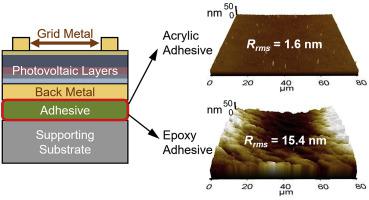当前位置:
X-MOL 学术
›
Curr. Appl. Phys.
›
论文详情
Our official English website, www.x-mol.net, welcomes your
feedback! (Note: you will need to create a separate account there.)
Highly Effective III-V Solar Cells by Controlling the Surface Roughnesses
Current Applied Physics ( IF 2.4 ) Pub Date : 2020-07-01 , DOI: 10.1016/j.cap.2020.05.001 Sun-Tae Hwang , Bumjin Gil , Alan Jiwan Yun , Jinhyun Kim , Jaewon Kim , Hyungsub Woo , Kimin Park , Byungwoo Park
Current Applied Physics ( IF 2.4 ) Pub Date : 2020-07-01 , DOI: 10.1016/j.cap.2020.05.001 Sun-Tae Hwang , Bumjin Gil , Alan Jiwan Yun , Jinhyun Kim , Jaewon Kim , Hyungsub Woo , Kimin Park , Byungwoo Park

|
abstract An advanced approach to minimize the light loss was discussed for III-V solar cells, by controlling the roughnesses of the device surface. Adhesives with different viscosities were applied to bond the III-V solar cells with the supporting substrate before the epitaxial lift-off process. The surface roughness of the III-V solar cells with epoxy adhesive (Rrms = 15.4 nm) is one order of magnitude higher than that with acrylic adhesive (Rrms = 1.6 nm), due to the differences in viscosity, resulting from the spreadability while being hardened. This roughness has increased the reflectance in the wavelength between 650 and 900 nm, implying that this reflectance is influenced by the rear surface of the solar cell. The device performance of the double-junction solar cells (Ga0.5In0.5P- and GaAs- based) also reflects the effect of the reflectance. The solar cell with the epoxy adhesive exhibited ~2% increase of the conversion efficiency than that with the acrylic adhesive, mainly due to the increased current density. The integrated current density from the external quantum efficiency (EQE) also exhibited ~2% increase only in the bottom (GaAs-based) cell, corresponding to the higher reflectance for red and near-infrared wavelength ranges.
中文翻译:

通过控制表面粗糙度的高效 III-V 太阳能电池
摘要 讨论了一种通过控制器件表面粗糙度来最大限度减少 III-V 族太阳能电池光损失的先进方法。在外延剥离工艺之前,使用不同粘度的粘合剂将 III-V 族太阳能电池与支撑基板粘合在一起。使用环氧树脂粘合剂的 III-V 族太阳能电池的表面粗糙度(Rrms = 15.4 nm)比使用丙烯酸粘合剂(Rrms = 1.6 nm)的 III-V 太阳能电池的表面粗糙度高一个数量级,这是由于粘度的差异,这是由延展性导致变硬了。这种粗糙度增加了波长在 650 到 900 nm 之间的反射率,这意味着该反射率受太阳能电池背面的影响。双结太阳能电池(Ga0.5In0.5P-和GaAs-基)的器件性能也反映了反射率的影响。使用环氧树脂粘合剂的太阳能电池比使用丙烯酸粘合剂的太阳能电池的转换效率提高了约 2%,这主要是由于电流密度的增加。来自外部量子效率 (EQE) 的积分电流密度也仅在底部(基于 GaAs 的)电池中增加了约 2%,对应于红色和近红外波长范围的更高反射率。
更新日期:2020-07-01
中文翻译:

通过控制表面粗糙度的高效 III-V 太阳能电池
摘要 讨论了一种通过控制器件表面粗糙度来最大限度减少 III-V 族太阳能电池光损失的先进方法。在外延剥离工艺之前,使用不同粘度的粘合剂将 III-V 族太阳能电池与支撑基板粘合在一起。使用环氧树脂粘合剂的 III-V 族太阳能电池的表面粗糙度(Rrms = 15.4 nm)比使用丙烯酸粘合剂(Rrms = 1.6 nm)的 III-V 太阳能电池的表面粗糙度高一个数量级,这是由于粘度的差异,这是由延展性导致变硬了。这种粗糙度增加了波长在 650 到 900 nm 之间的反射率,这意味着该反射率受太阳能电池背面的影响。双结太阳能电池(Ga0.5In0.5P-和GaAs-基)的器件性能也反映了反射率的影响。使用环氧树脂粘合剂的太阳能电池比使用丙烯酸粘合剂的太阳能电池的转换效率提高了约 2%,这主要是由于电流密度的增加。来自外部量子效率 (EQE) 的积分电流密度也仅在底部(基于 GaAs 的)电池中增加了约 2%,对应于红色和近红外波长范围的更高反射率。











































 京公网安备 11010802027423号
京公网安备 11010802027423号